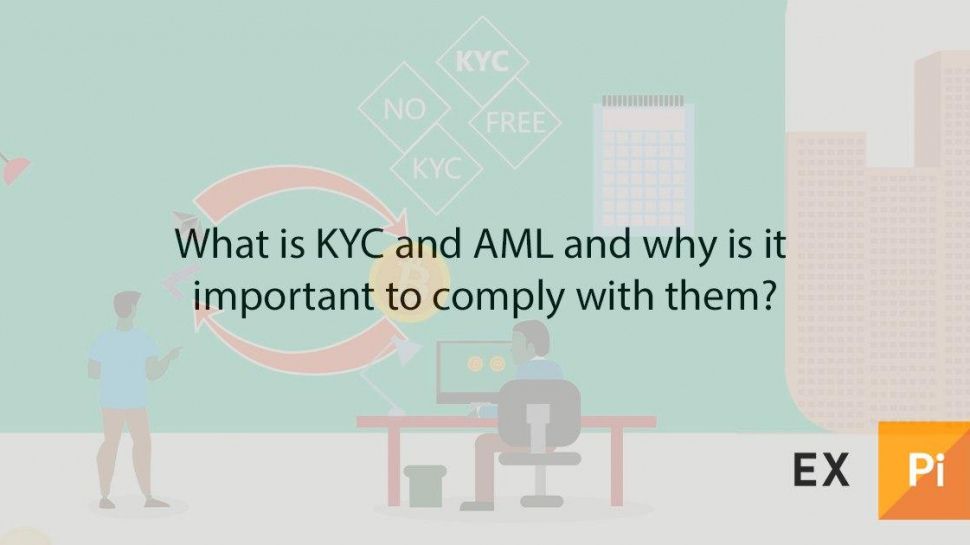What is KYC and AML?

Financial security is number one in the activities of all organisations. And if in the case of trade in goods and services, insurance against risks is carried out by the terms of the contract, then in the case of financial technologies, the instruments of operations themselves include security measures.
Alex Zask, Chief Development Officer EXPi talks about what constitutes an anti-money laundering policy, when and why it became an important part of the security policy of Pi Capital Union companies.
KYC and AML — principles of counter party / client awareness
The modern world is increasingly striving to remove anonymity from financial circulation. It is difficult to find a “bearer” account in banks, and it is absolutely impossible to take out a loan without at least two documents proving identity, creditworthiness, marital status, and so on. It is often possible to even buy cash only with a passport. A brokerage account is opened according to documents, tied to the phone, bank cards. There are many such examples.
The reasons are simple:
- people don’t want to lose their money;
- governments are fighting illegal money and terrorist financing.
That is why stable abbreviations — KYC and AML — appeared in foreign law and customs of business turnover in the 2000s.
The concept of KYC appeared in official documents in 2016 in the USA. The Treasury’s Financial Crime Department FinCEN introduced formal KYC requirements, although this abbreviation was previously used in documents of private companies.
AML is a concept with a longer history. It was officially consolidated after the creation of the Financial Action Task Force on Money Laundering — FATF — in 1989 in Paris.
In fact, the second abbreviation includes the first, but they often appear side by side in texts. Let’s understand their meanings.
KYC
KYC — Know Your Customer or Know Your Client. This is the principle of the activities of financial institutions (banks, stock exchanges, bookmakers, investment and mutual funds), obliging them to identify the counter-party before conducting a financial transaction. The goal of such a policy is to better understand the clientele, monitor financial transactions, reduce client risks, and prevent bribery and corruption.
Example: specific KYC procedures in banks are cash withdrawal limits or additional verification of the customer’s identity by SMS code.
KYC procedures are designed to help financial institutions better understand their customers and monitor the risks of transactions.
Among them, the main ones can be distinguished:
- clientele acceptability policy (bank, insurer, stock exchange or lender determines who can become their client);
- client identification procedures (obtaining basic data about the client, such as passport data, birth certificate, open data on property and others);
- tracking transactions;
- risk management (comparison of data on the quantity, content of transfers, counter-parties, material support, and so on).
Procedures aimed at improving the security of transactions, the client of financial institutions, banks and, ultimately, states, which are very actively used in Russian financial institutions. Moreover, not only in banks with foreign capital, companies with a financial profile with state participation are often the pioneers of innovations.
AML
AML — Anti-Money Laundering. To be absolutely precise, the abbreviation should have been longer, AML CFT CWMDF — anti-money laundering and counter-terrorist financing and counter-weapons of mass destruction financing. destruction).
This is the full mission of a non-governmental international organisation, the Financial Action Task Force on Money Laundering. Parts of this long acronym are found in many financial documents, manifestos of openness, company security policies.
Financial institutions consider the following business actions as triggers for initiating AML audits:
- doing business on a cash basis (or a significant amount of the company’s funds in cash);
- keeping company money in different accounts, including several banks;
- transfer of funds abroad;
- purchase of cash settlement instruments (for example, futures, forwards, options and currency derivatives);
- investing in securities through brokers or dealers, especially those affiliated with the company.
It is obvious that customer identification (KYC) is only part of anti-money laundering (AML). KYC can be called a set of procedures and tools, a principle within the general AML / CFT policy. CDD, EDD and KYCC are considered to be the same part of the general AM / CFT policy.

Services
Read our blog to learn more about cryptocurrency and how you can use it for everyday life.
©2019—2022 BERTES INVEST OU
EXPi trade ® is registered trademark of Bertes Invest OU. Bertes Invest OU (reg. No 12449024) is registered in Estonia with its registration address at Harju maakond, Tallinn, Kesklinna linnaosa, Veskiposti tn 2, 10138, Estonia. Bertes Invest OU operates under Financial services, Providing a virtual currency services license (license number: FVT000291), issued by Estonian Financial Intelligence Unit. Contact phone number: +372 601 9100; e-mail: info@expi.trade.
Risk Awareness
